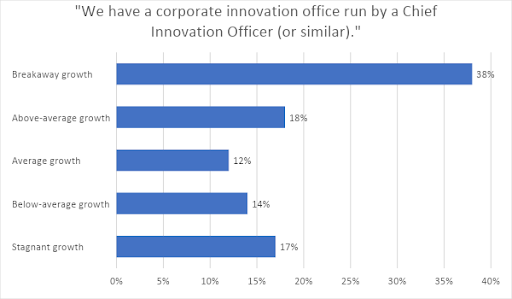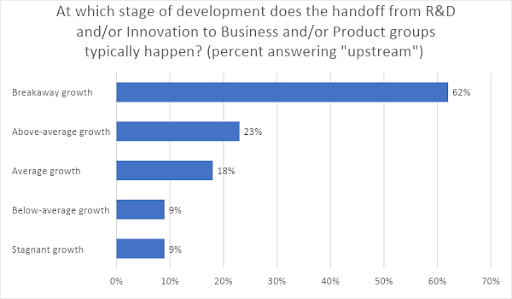The Chief Innovation Officer’s Three Core Roles

In recent years, the position of Chief Innovation Officer (CINO) has gone from a footnoted curiosity to a mainstream trend. And now we have data-driven evidence that CINOs play an important role in driving growth for their companies. In Wellspring’s 2021 R&D and Innovation Agenda report, the presence of a CINO was one of several factors that correlated strongly and positively with superior corporate performance. Among companies that significantly outpaced their industry peers in revenue growth, 38% had a corporate innovation office led by a CINO – versus 14% of all other companies. And qualitative indications from our study suggest those percentages are likely to continue rising in the years to come, especially among the most successful firms.
 Source: Wellspring, The 2021 R&D and Innovation Agenda, September 2021
Source: Wellspring, The 2021 R&D and Innovation Agenda, September 2021
In other words, if your company plans to take innovation seriously, you’ll probably need to create a corporate innovation office run by a CINO. If you haven’t already.
It’s critical to get the design right. Corporate innovation teams, especially when they’re relatively new, can quickly wind up in purgatory. Needing to prove her team’s worth, the CINO may find it necessary to get involved in boondoggles – thus neglecting table-setting for long-term success.
If you’re stepping into a CINO role, or if your company wants to create a corporate innovation office, know that a sustainable innovation mission must play three overlapping roles. If you short-change these roles, failure is just a matter of time. Whereas if you equip the innovation function to play these roles, success will follow.
1. Guide innovation strategy
Ultimately, the CEO is the arbiter of the company’s innovation direction. But if the CINO abdicates too much strategy-setting, innovation becomes nothing more than a cut-and-paste version of the corporate growth plan. As we’ve written elsewhere, this is a huge mistake. In order to properly serve the overall corporate agenda, innovation must have its own strategy, rooted in its own operating logic. It’s no different than the need for a Sales strategy or a Marketing strategy.
Managing the innovation strategy is more than just setting a good plan. It’s also about the high-level decision-making necessary to execute that plan. Even the most speculative innovation bets usually pass through multiple teams beyond the core innovation group. As projects advance, this cross-functional jigsaw puzzle grows more complex, making it critical for senior executives to help make the calls and clear the path. These decision-makers must be able to exert organization-wide authority, either individually or as a group. In almost all cases, this means that the Chief Innovation Officer must work closely with the CEO and/or a senior-level innovation steering committee.
It’s important to remember that both the planning and the execution of innovation strategy is a moving target. The advent of new technologies, new market dynamics, and new customer trends will have a substantial impact on the best-fit innovation plan going forward. The Chief Innovation Officer and her team plays a critical role in noticing the early-warning signals of emerging technologies and market shifts – and then bringing those insights back to the corporate leadership team. At times, these innovation signals will trigger fundamental adjustments to the corporate growth strategy.
2. Drive exploratory innovation
The core innovation team’s efforts often end up concentrated in incremental (Horizon 1) type projects. This is not usually by design; more typically it’s because short-term needs from around the business create a center-of-gravity that is impossible to ignore. Many new CINOs decide early in their tenure that they need to help the mainline businesses today, in order to argue for an elevated mission tomorrow.
Depending on the level of strategic air cover from above, the CINO may initially have no other option. But in the mid- to long-term, merely supporting incremental wins “in the business” is neither an ownable nor a sustainable mission for the innovation team. To thrive as a permanent component of the company’s growth engine, the CINO must carve out a role through which her team can add unique, mission-critical value. In the vast majority of cases, that means driving the company’s portfolio of exploratory innovation bets.
We use the term “exploratory” here on purpose – rather than “disruptive” or “transformative.” The important point is that the innovation team must focus on seeding strategic bets for mid- to long-term innovation value. Such bets are too speculative to fit within the incentive structures of almost any other team or function – and yet they are crucial to firm competitiveness over time. The CINO’s unique role is to systematically incubate next-gen technology platforms and go-to-market concepts, until they have been de-risked and validated for conventional scale-up and launch. The critical threshold comes when a viable investment case can be made within one of the mainstream product or business groups.
3. Coordinate downstream innovation
As we’ve seen, the CINO’s team makes a unique contribution to the company by developing and incubating exploratory bets. Beyond that, the goal is to transition projects into key operating units as efficiently as possible. Our 2021 survey data are unmistakable on this point: among the best-performing companies, 62% of innovation teams transition their projects upstream in the pipeline, versus 15% of everyone else. The innovation team performs best when it sticks to its core strengths.
 Source: Wellspring, The 2021 R&D and Innovation Agenda, September 2021
Source: Wellspring, The 2021 R&D and Innovation Agenda, September 2021
Nonetheless, how you execute the handoff is critical. Copious anecdotal evidence suggests that botched internal transitions kill promising innovations at least as much as any other cause. To do it well, the innovation team must play a central role.
Poor pipeline transitions come in two flavors: a) those that are too late, and b) those that are too sudden.
If the innovation team waits too long to hand off a project, they’re performing tasks that are better left to functions like Product Engineering, Manufacturing, and Marketing. This leads to confusion about who’s driving the bus, mistrust among various departments, and poor time allocation within the innovation team. On the other hand, if the handoff becomes a toss-it-over-the-wall exercise, the downstream folks will typically misconstrue key aspects of a given innovation – especially those that are highly technical or specialized. If you simply drop an innovation project on another team’s doorstep, you consign it to a slow orphaned demise.
The best practice is to maintain a blended team structure throughout the innovation lifecycle. Early in the process, when the work is highly speculative, the innovation team does the legwork while keeping downstream units informed of their key activities and strategic aiming points. Later in the pipeline, members of the innovation team must stay involved in a support capacity as project liaisons and technical advisors. Although their time commitment is vastly reduced, it’s the innovation team’s responsibility to ensure that downstream teams don’t lose sight of the initial sparks that made those innovations valuable in the first place.
Be the innovation leader your company needs
As it goes in life, so it goes in corporate innovation. Taking the easy path may start off well, but you run into diminishing returns over time. Conversely, if you put in the difficult work up-front, and if you stay on that path through the ensuing bumps and challenges, you will be rewarded many times over.
Many CINOs find it difficult to firmly establish their teams as described above. Even though these “three roles” are what the company ultimately needs from its innovation team, they’re often not what the company says it wants from one day to the next. If you’re the CINO and you only listen to knee-jerk desires from the business, you are doing the company a grave disservice. You are relegating the innovation function to shaky ground.
Only when the CINO’s three critical roles are well-established can the innovation team take on a lasting form – one that is deeply rooted in fundamental value-creation for the company. That doesn’t mean your only activities as the CINO should be focused on securing the three roles, since that is rarely practical. Nevertheless, you must make time for it, no matter how much effort you expend playing politics, fighting fires, and delivering quick wins. To achieve stable success, the fulfillment of innovation’s three critical roles must be your ultimate goal.
